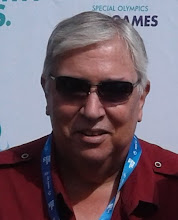Of Little Rocks and Style Put-On: The Way It Was, 4 August
FEATURED BROADCAST
THE LES PAUL SHOW:
LITTLE ROCK GETAWAY
(NBC, 1950)
THE LES PAUL SHOW:
LITTLE ROCK GETAWAY
(NBC, 1950)
That charming little masterwork of overdubbing, tape speeding, and sheer virtuosity---which also opened a late May program---gets a slight re-arrangement to kick off this installment of the guitar pioneer's short-enough-lived radio exercise, which also includes a charming performance of "Until I Hold You Again" by then-wife Mary Ford; and, a pungent Paulist take of a country chestnut, "Puttin' On the Style," among the music highlights that are the real treat, since the couple's on-air banter (none of it scripted) isn't exactly going to make you think you've discovered two of the great lost American comedians.
AIRWAVES . . .
1901: A HORN IS BORN---In terms of hard old-time radio history, this isn't exactly a hot date . . . unless, of course, you could predict that the infant born today in a poor New Orleans neighbourhood will grow up to learn his first music in reform school, after he fires a gun for a New Year's celebration at age eleven, never mind to revolutionise jazz and charm radio listeners (on The Pursuit of Happiness; Sealtest Village Store; The Story of Swing; The Frank Sinatra Show; and The Big Show, among others) as well as ballroom goers and record buyers.
Louis Armstrong was the first important soloist to emerge in jazz, and he became the most influential musician in the music's history. As a trumpet virtuoso, his playing, beginning with the 1920s studio recordings made with his Hot Five and Hot Seven ensembles, charted a future for jazz in highly imaginative, emotionally charged improvisation. For this, he is revered by jazz fans. But Armstrong also became an enduring figure in popular music, due to his distinctively phrased bass singing and engaging personality, which were on display in a series of vocal recordings and film roles.---From All Music Guide.I talked with Louis Armstrong one night in Basin Street and mentioned his record of "When You're Smilin'" which I had early loved and too soon lost: "I was working in the house band at the Paramount when I was young," Armstrong said. "And the lead trumpet stood up and played that song, and I just copied what he did note for note. I never found out his name but there was kicks in him. There's kicks everywhere."---Murray Kempton, introducing his anthology, Rebellions, Perversities, and Main Events. (New York: Times Books/Random House, 1994.)
CHANNEL SURFING: SATCHMO ON THE AIR
REMOTE: NEW YEAR'S RADIO DANCING PARTY (ARMED FORCES RADIO SERVICE, 31 DECEMBER 1945)---Leading a big band of his own, Armstrong delivers both an exuberant trumpet and vocal performance playing "Ac-cen-tu-ate The Positive." ("Well, flock!" "Yeah, leader!" "Have you hoid what Brother Moicer said?") That's one of the highlights of a New Year's Eve radio multi-remote---hookups from hotel to hotel---that also includes Harry James ("Sad Sack"), Count Basie ("One O'Clock Jump"), Jimmy Dorsey ("I Got Rhythm"), Artie Shaw with Roy Eldridge ("Little Jazz"), Stan Kenton ("Tampico," with vocalist June Christy), Tommy Dorsey ("Song of India"), Duke Ellington ("Let the Zoomers Zoom"), and, perhaps needless to say, Guy Lombardo ("Auld Lang Syne").
THE BIG SHOW: AIN'T MISBEHAVIN' (NBC, 17 DECEMBER 1950)---Satchmo makes a swinger out of Meredith Willson, when the grandfather of the swing slips up from the Willson orchestra pit, banters with Bob Hope and hostess Tallulah Bankhead, then growls and blows a marvelous "Ain't Misbehavin'." Additional cast: Phil Harris, Deborah Kerr, Frankie Lane, Martin & Lewis. Announcer: Ed Herlihy. Writers: Goodman Ace, Selma Diamond, Frank Wilson.
CHANNEL SURFING: THE USUAL . . .
WORLD NEWS TODAY: THE EUROPEAN BATTLES CONTINUE (CBS, 1944)---Including the continuing battle in and for Normandy, as future Radio Hall of Famer Douglas Edwards anchors.
BOB & RAY PRESENT THE CBS RADIO NETWORK: WHO WANTS TO KNOW? (WHO CAN GUESS, 1959)---Maybe you do, if you listen to today's edition. Writers: Bob Elliot, Ray Goulding.
PREMIERING TODAY . . .
1889---William Keighley (host: Lux Radio Theater), Philadelphia.
1890---Carson Robison (singer: The Eveready Hour; The Dutch Masters Minstrels), Chetona, Kansas.
1897---Abe Lyman (bandleader: The Jack Pearl Show; Lavender and New Lace; Waltz Time), Chicago.
1903---Helen Kane (The Boop Boop-a-Doop Girl; actress: Today's Children), The Bronx.
1904---Theodore Newton (actor: Joyce Jordan, M.D.), Lawrenceville, New Jersey.
1905---Frank Luther (singer: The Frank Luther Show; The Happy Wonder Bakers Trio), Lakin, Kansas.
1908---Wally Maher (actor: One Man's Family; The Adventures of Nero Wolfe), Montreal.
1914---Dick Todd (singer: Avalon Time; Your Hit Parade; The Rinso-Spry Vaudeville Theater), Montreal.
1915---William Keene (actor: Land of the Lost), Pennsylvania.
1890---Carson Robison (singer: The Eveready Hour; The Dutch Masters Minstrels), Chetona, Kansas.
1897---Abe Lyman (bandleader: The Jack Pearl Show; Lavender and New Lace; Waltz Time), Chicago.
1903---Helen Kane (The Boop Boop-a-Doop Girl; actress: Today's Children), The Bronx.
1904---Theodore Newton (actor: Joyce Jordan, M.D.), Lawrenceville, New Jersey.
1905---Frank Luther (singer: The Frank Luther Show; The Happy Wonder Bakers Trio), Lakin, Kansas.
1908---Wally Maher (actor: One Man's Family; The Adventures of Nero Wolfe), Montreal.
1914---Dick Todd (singer: Avalon Time; Your Hit Parade; The Rinso-Spry Vaudeville Theater), Montreal.
1915---William Keene (actor: Land of the Lost), Pennsylvania.












0 Comments:
Post a Comment
Subscribe to Post Comments [Atom]
<< Home